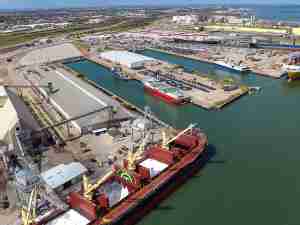The move of the container trade from Mina Zayed, a long-established port that has served Abu Dhabi for over 40 years, to Khalifa Port, the region’s newest and only semi-automated terminal, was completed three months ahead of schedule and less than three months after the new port began commercial operations on September 1st, 2012.
The last container vessel to call at Mina Zayed was the Jolly Arancione voy 290, a ship belonging to the Italy-headquartered Messina Line. The mixed-use ship can transport 1,800 TEUs, an industry term for twenty-foot-long containers, on its deck and dozens of wheeled vehicles in a seven-level multi-storey car park in its hull.
“Personally, I’m leaving a piece of my heart here,” said Captain Giordano Gelasini, Messina Line’s Resident Regional Director for the Middle East, as he stood on the bridge, watching the gantry cranes unload containers for storage among the remaining boxes in the yard.
Mina Zayed started operating in June 1972, making it just six months younger than the UAE. It will continue to welcome cruise liners and deliver dry bulk cargo, such as granules of steel or grain, break bulk cargo, including large materials for infrastructure projects, and roll-on/roll-off cargo – wheeled vehicles – to the local market.
“We were the first to call at Abu Dhabi and we will be the last,” the Captain, who started working for Messina Line nearly 30 years ago, added. “We have more history with Mina Zayed than any other shipping line. We were the first to believe in this city and we’ve grown together.”
Since the first Messina Line ship arrived at the port on February 18th, 1995, the family-run business has shipped more than 600,000 TEUs through the facility in over 400 shipments; many voyaged from Genoa to the Suez Canal before traversing the Red Sea and circumnavigating the Arabian Peninsula.
The goods brought by the Italian liner have been used in some of Abu Dhabi’s most famous projects, including Sheikh Zayed Mosque and Ferrari World. Companies that have made use of the shipping line’s services include Emirates Steel, Borouge, a local plastics manufacturer, and Abu Dhabi National Oil Company.
The Messina Line will be the last of 24 major shipping lines to swiftly graduate their local container businesses to the new port at Taweelah.
“For many years, Mina Zayed was our hub for the upper and lower Gulf and the Indian Subcontinent, but now, we are looking ahead to the new and very impressive Khalifa Port. Its technology and infrastructure will enable it to turn around vessels much more efficiently, and the time saved will benefit our customers,” he said.
Mina Zayed handled around 770,000 TEUs in 2011. With an initial capacity to handle 2.5 million TEUs annually and the potential to expand to 5 million, Khalifa Port more than compensates for the capacity lost by the end of the container business near the city centre.
It can also handle 12 million tonnes of general cargo every year.
“With the strategic redirection of container traffic to Khalifa Port, Abu Dhabi’s ports have the capacity to handle more containers, more cargo and more cruise liners,” said Martijn Van de Linde, the Chief Executive Officer of ADT. “The extra capacity gives every business and government entity in Abu Dhabi the means to grow and develop.”
He added: “Khalifa Port is an engine driving Abu Dhabi’s economic diversification.”
Khalifa Port has six of the world’s largest ship-to-shore cranes and an automated stacking system that is more advanced than any other port facility in the Middle East. Its deep sea berths can accommodate the largest container vessels roaming the seas.
“The deep berths will enable us to take the big ‘main line’ ships from Europe and Asia for the first time and eliminate the need for feeder ships to service the local market from larger regional ports,” Mr Va










